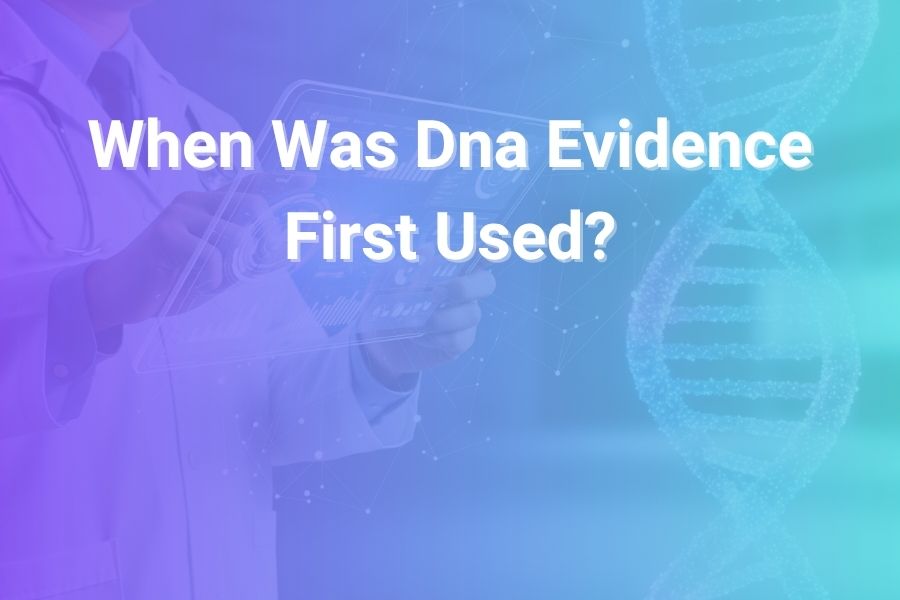The use of DNA evidence transformed the criminal justice system forever. Before its introduction, investigators relied heavily on eyewitness accounts, fingerprints, and circumstantial evidence, which often left room for error. The discovery that human DNA is unique to each individual revolutionized forensic science.
It allowed courts to link suspects to crimes with remarkable precision and even free innocent people from wrongful convictions. Understanding when and how DNA evidence was first used gives insight into how science reshaped law enforcement and justice worldwide. In this article, you will learn when DNA evidence was first used, how it became a cornerstone of modern investigations, and why it remains one of the most trusted forms of forensic proof today.
The Birth of DNA Fingerprinting
The story of DNA evidence began in 1984 when British geneticist Sir Alec Jeffreys, working at the University of Leicester, made a groundbreaking discovery. While examining genetic samples, he realized that every person’s DNA carried unique repeating patterns that could distinguish one individual from another.
This led him to develop “DNA fingerprinting,” a method that could identify people with near-perfect accuracy. Jeffreys’ discovery was not initially aimed at criminal investigations; he was researching hereditary diseases and paternity disputes. However, the potential of his findings quickly drew the attention of law enforcement.
Within two years, his method would be tested in one of the most important criminal cases in modern history. The turning point came in 1986, when two teenage girls, Lynda Mann and Dawn Ashworth, were raped and murdered in the small town of Narborough, England.
The brutal crimes shocked the nation, and the police struggled to find the perpetrator. At first, a 17-year-old local youth named Richard Buckland confessed under pressure to one of the murders, though he denied the second. The evidence against him was weak, but investigators believed they had found their man—until DNA entered the scene.
The First Criminal Case Solved by DNA
When Jeffreys was contacted to assist, he analyzed DNA samples from both victims and compared them with Buckland’s genetic profile. The results were astonishing. Buckland’s DNA did not match either crime scene. For the first time in legal history, DNA evidence proved someone’s innocence in a major criminal case. This revelation prompted police to launch an unprecedented mass DNA screening of over 5,000 local men in the area to find a match. After months of testing, none of the samples matched the crime scene DNA. The case seemed unsolvable—until a twist of fate intervened.
A local bakery worker, Colin Pitchfork, persuaded a friend to provide a sample under his name to avoid giving his own DNA. The deception was later exposed when a co-worker overheard the confession and informed the police. Investigators obtained Pitchfork’s real DNA, and it perfectly matched the samples from both victims. In 1987, he was arrested and later convicted, marking the first time DNA evidence was used to both exonerate an innocent man and convict the true offender. This single case demonstrated the immense power of DNA technology in ensuring justice.
How DNA Evidence Entered the United States
The success of the Pitchfork case spread rapidly across the world. In the United States, the first criminal conviction using DNA evidence took place in 1987 in Florida. The case involved a man named Tommy Lee Andrews, who was accused of sexual assault. DNA tests from the crime scene matched his genetic profile, leading to his conviction. This marked the start of a new era in American law enforcement. Soon after, state and federal agencies began establishing DNA laboratories and standardizing procedures for testing.
By the early 1990s, DNA evidence had become a critical part of investigations across the country. The FBI launched the Combined DNA Index System (CODIS) in 1990, a national database that stores DNA profiles from convicted offenders and crime scenes. This system helped police solve cold cases and identify repeat offenders. As of 2025, CODIS contains over 22 million profiles and has aided in solving more than 600,000 investigations in the U.S. alone.
Evolution of DNA Testing Methods
The earliest DNA tests, such as restriction fragment length polymorphism (RFLP) analysis, required large and well-preserved samples, which often limited their use in older cases. Advances in molecular biology led to the development of polymerase chain reaction (PCR) technology in the late 1980s. PCR allowed scientists to amplify small amounts of DNA, making it possible to analyze minute traces from hair, saliva, or blood.
Modern techniques, such as short tandem repeat (STR) analysis, have further increased accuracy and efficiency. STR testing examines specific regions of DNA that vary greatly between individuals, producing a genetic “barcode.” This method is now the global standard for forensic DNA testing. Continuous improvements in sequencing technology and automation have also reduced the time required for analysis from weeks to hours.
Impact on Criminal Justice and Society
The introduction of DNA evidence reshaped how crimes are investigated, prosecuted, and adjudicated. It has become a powerful tool for both conviction and exoneration.
According to the Innocence Project, more than 375 people in the United States have been exonerated since 1989 based on DNA testing. Many of these individuals spent decades in prison for crimes they did not commit. DNA testing has therefore not only advanced forensic science but also strengthened human rights by preventing miscarriages of justice.
In addition, DNA evidence has helped solve thousands of cold cases that were once considered unsolvable. Law enforcement agencies have reopened decades-old murder and sexual assault investigations, often identifying suspects long after the crimes occurred. Notably, in 2018, DNA genealogy led to the arrest of the Golden State Killer, a serial murderer and rapist active during the 1970s and 1980s. Investigators matched DNA from crime scenes with genetic data uploaded to public ancestry databases, showing how far the science has progressed since the 1980s.
DNA Evidence in Modern Law Enforcement
Today, DNA testing is used in nearly every type of criminal investigation, from homicide to burglary. The process has become faster, cheaper, and more accessible. Portable DNA analyzers now allow investigators to perform rapid testing directly at crime scenes, producing results in under two hours. This technology is being adopted by police departments across the U.S., streamlining investigations and reducing backlogs in forensic labs.
The reliability of DNA evidence has also prompted courts to refine legal standards for its use. In the U.S., the admissibility of DNA evidence was first challenged in the late 1980s but was soon upheld as a scientifically valid method. Judges and juries now view DNA as one of the most persuasive forms of evidence available. However, experts caution that while DNA can identify or exclude suspects, it cannot determine guilt by itself. Context, chain of custody, and interpretation remain crucial.
Ethical and Privacy Concerns
With great power comes responsibility, and DNA evidence is no exception. The growing use of genetic databases has raised serious questions about privacy and consent. Critics argue that large-scale DNA collection could lead to misuse or discrimination. In the United States, laws such as the DNA Identification Act and the Genetic Information Nondiscrimination Act were established to protect individuals from having their genetic data used improperly.
Furthermore, as consumer DNA testing services like 23andMe and Ancestry.com grow in popularity, law enforcement agencies have increasingly turned to public databases for leads. While this approach has solved many high-profile crimes, it also raises concerns about whether individuals truly understand how their genetic data might be used. Balancing public safety with individual privacy continues to be an evolving debate.
Scientific Advances and Future Potential
The future of DNA evidence lies in next-generation sequencing and artificial intelligence. Scientists can now analyze whole genomes to detect subtle variations that were once undetectable.
AI tools help match partial DNA profiles, improving results in complex or degraded samples. These technologies could soon allow forensic experts to create predictive models of a person’s appearance or ancestry based solely on DNA traces, a concept known as “forensic phenotyping.”
Additionally, environmental DNA (eDNA) analysis is emerging as a new frontier. This method detects trace genetic material in air, water, or soil to determine whether a person or species was present in a location. It could revolutionize crime scene analysis in the years ahead.
Real-World Impact and Statistics
By 2025, DNA evidence plays a role in over 90% of violent crime prosecutions in the United States. The average turnaround time for laboratory analysis has decreased by 40% since 2015, thanks to automation and digital tracking systems. The global forensic DNA testing market, valued at around $3.8 billion in 2024, continues to grow annually, driven by demand for advanced sequencing methods and backlog reduction initiatives. These statistics show how DNA testing has evolved from an experimental technique into a cornerstone of modern policing and justice.
Conclusion: A Scientific Revolution in Justice
When DNA evidence was first used in the mid-1980s, few could have predicted its profound impact on society. What began as a scientific discovery in a university lab transformed into a global tool for truth and justice. The Colin Pitchfork case proved that DNA could speak louder than confessions or eyewitness testimony. Since then, its use has expanded across continents, freeing the innocent and convicting the guilty with unprecedented precision.
Today, nearly four decades later, DNA remains the gold standard of forensic identification. It stands as a reminder that science and justice, when combined, can change lives, restore faith in legal systems, and protect future generations from the errors of the past. The story of when DNA evidence was first used is more than history—it’s the origin of modern truth in the courtroom.







